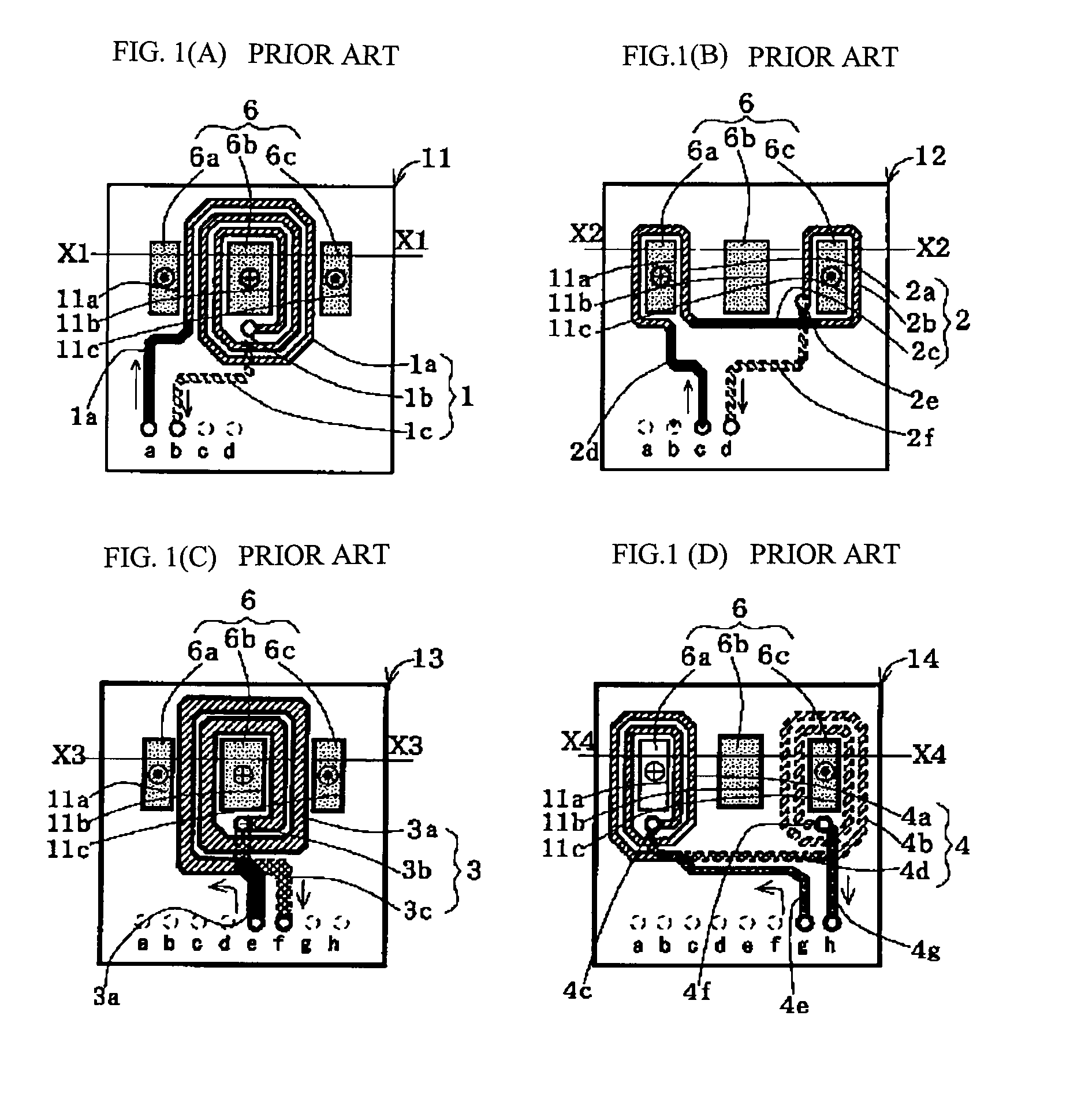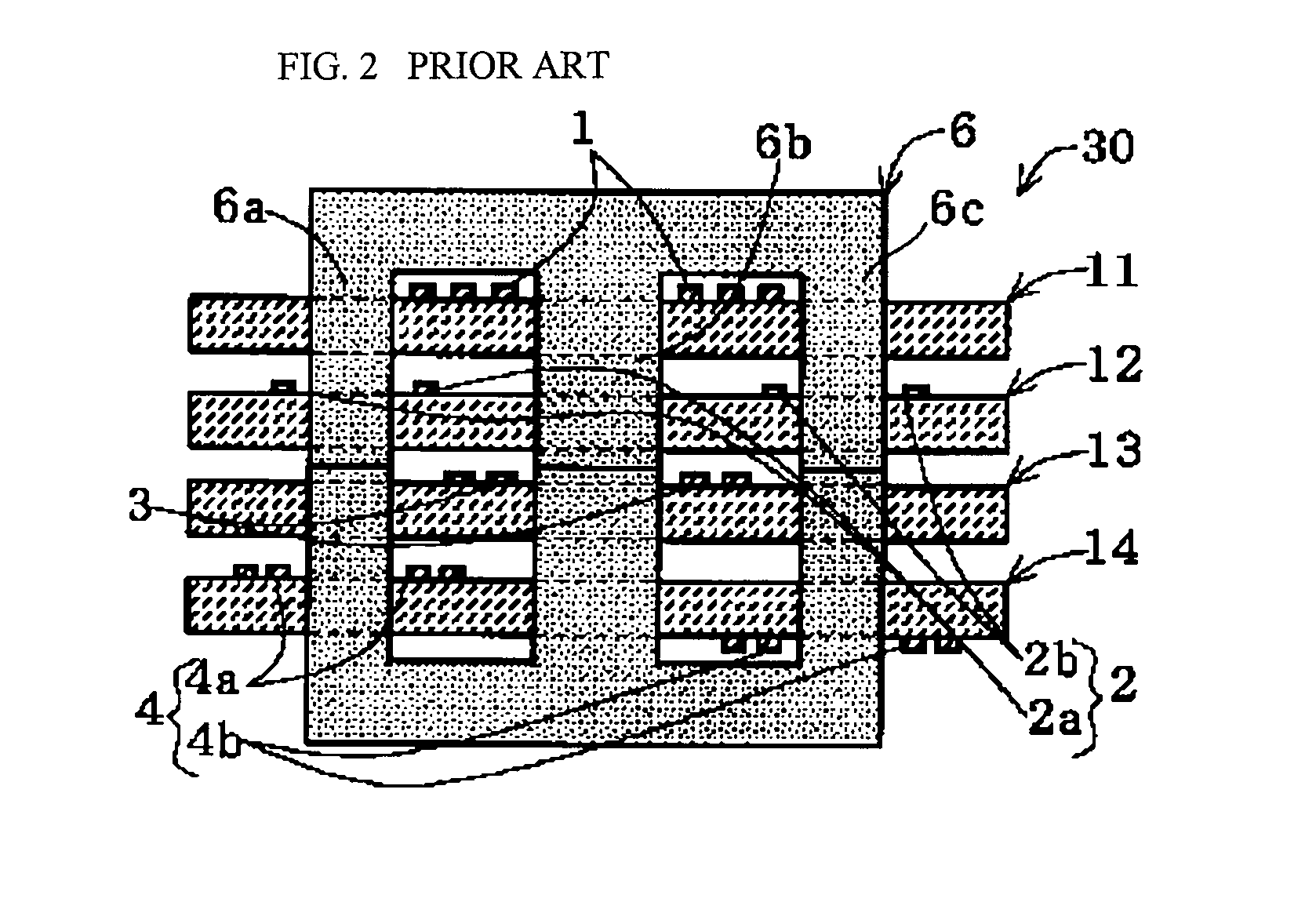Composite transformer and insulated switching power source device
a technology of switching power source device and composite transformer, which is applied in the direction of transformer/inductance coil/winding/connection, inductance, printed electric component incorporation, etc., can solve the problems of large area needed for pattern wiring, interference between individual transformer units, and malfunction of electronic devices using transformer units, so as to reduce the loss, less interference, and the effect of less al valu
- Summary
- Abstract
- Description
- Claims
- Application Information
AI Technical Summary
Benefits of technology
Problems solved by technology
Method used
Image
Examples
first embodiment
[0090]A transformer according to a first embodiment will be described on the basis of FIGS. 3(A)-4(B).
[0091](E) and (F) in FIG. 3 are cross-sectional views of main parts of a transformer. As illustrated in these FIGS. 3(E) and 3(F), the transformer is composed primarily of a printed board 110, an E-shaped core 106, and an I-shaped core 107.
[0092]FIG. 3(A) is a plan view of a first printed coil layer of the printed board 110 which is a multilayer substrate, (B) is a plan view of a second printed coil layer of the printed board 110, (C) is a plan view of a third printed coil layer of the printed board 110, and (D) is a plan view of a fourth printed coil layer of the printed board 110. These plan views includes the cross-sections of leg portions of the E-shaped core 106.
[0093]As illustrated in FIG. 3, the E-shaped core 106 has a middle leg 106b and a pair of outer legs 106a and 106c on opposite sides with respect to the middle leg 106b. In addition, the outer leg 106a is divided in the...
second embodiment
[0115]In the following, a transformer according to a second embodiment will be described with reference to FIG. 5.
[0116]FIG. 5 shows diagrams illustrating examples of wiring formed on a printed board used in the transformer according to the second embodiment. Note that for convenience of the description, the examples are shown in two layers, without illustration of four layers as in the case of FIG. 3. In the first embodiment, a four-leg core is used. However, in this second embodiment, a five-leg core is used, and one power transmission transformer unit and two signal transmission transformer units are provided.
[0117]The cross-sectional structure of the entire transformer is substantially the same as that described in the first embodiment, and thus the illustration thereof will be omitted and only parts different from the first embodiments will be hereinafter described.
[0118]An E-shaped core 106 has a middle leg 106b and one pair of outer legs 106a and 106c on opposite sides with r...
third embodiment
[0120]In the following, a transformer according to a third embodiment will be described with reference to FIG. 6.
[0121](E) and (F) in FIG. 3 illustrate a configuration in which the printed board 110 are sandwiched by the E-shaped care 106 and the I-shaped core 107. However, in this third embodiment, a detailed configuration for keeping the E-shaped core 106 and the I-shaped core 107 in an attached state.
[0122](A) in FIG. 6 is a plan view of a transformer formed together with a printed board 110, (B) is a right-side plan view of the transformer, and (C) is a front elevation view of the transformer.
[0123]The E-shaped core 106 and the I-shaped core 107 are fitted to each other by a core fixing metal member 108. The core fixing metal member 108 includes four claw portions 108f for engaging with the E-shaped core 106 at four points of the edges of the E-shaped core 106, a core side supporting portion 108s for supporting a center part of two longer edges of the I-shaped core, spring porti...
PUM
| Property | Measurement | Unit |
|---|---|---|
| voltage | aaaaa | aaaaa |
| drain voltage | aaaaa | aaaaa |
| temperature | aaaaa | aaaaa |
Abstract
Description
Claims
Application Information
 Login to View More
Login to View More - R&D
- Intellectual Property
- Life Sciences
- Materials
- Tech Scout
- Unparalleled Data Quality
- Higher Quality Content
- 60% Fewer Hallucinations
Browse by: Latest US Patents, China's latest patents, Technical Efficacy Thesaurus, Application Domain, Technology Topic, Popular Technical Reports.
© 2025 PatSnap. All rights reserved.Legal|Privacy policy|Modern Slavery Act Transparency Statement|Sitemap|About US| Contact US: help@patsnap.com



